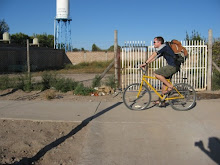 With the exception of walking to the village of Buenos Aires, we are always required to be accompanied by a local guide. These guys are great, and I am glad they are here, not only because they protect us from the variety of harms of the jungle such as snakes and individuals of various illegal enterprises, but they are also the main source of cultural wealth amidst a steady sea of gringos and an easily accessible, and patient, means by which we can practice our Spanish.
With the exception of walking to the village of Buenos Aires, we are always required to be accompanied by a local guide. These guys are great, and I am glad they are here, not only because they protect us from the variety of harms of the jungle such as snakes and individuals of various illegal enterprises, but they are also the main source of cultural wealth amidst a steady sea of gringos and an easily accessible, and patient, means by which we can practice our Spanish.The guides, or guias in Spanish, come in a variety of personalities, ages (one can't be much more than fourteen) and names, including Santiago, Antonio, Manuel, and Jesus, but they all share some certain commonalities, the most obvious of these being the ever-present machetes. The long, sharp knives never leave the guides' sight, and are used for everything from personal safety to hacking down vines obstructing forest trails. The blades are kept in prime condition using sharpening stones, a process from which I've seen emerge blood from the guide's hand after a subtle slip. But, instead of pausing to get cleaned up, the guy just keep sharpening, blood and all, with the same wide grin he had when he started.
Another common trait most of the guides share is their physical appearance and condition. With few exceptions, I would say that most of the guias stand only around five and a half feet tall, which may not sound like a stature worthy of protecting large groups of people, but the lack of height is also accompanied by a complete lack of fat. If you look up the word "lean" in the dictionary, you will find a photo of our guides next to it. These guys can hike all day, every day, with comparatively little water and even less complaining. And, in addition to endurance, our amigos are surprisingly strong- i've seen them routiney carrying a bundle of sixteen small mammal traps on one shoulder, and another guy actually carrying a generator on his back. Some of the guides will come back from a fast 90-minute "hike" that more closely resembles a jog, and still find the energy to play a game of soccer.
I recently visited my first forest camp, Cantiles, and came back in the same day. There are certainly more difficult trails here, but the camino to Cantiles is far from easy with its slippery, narrow tracks so steep in spots that guide ropes have been installed. The last stretch in particular contains such trails, and takes a good 35 minutes, at a good pace, on the return trip. A few weeks ago, however, there was a snake bite "drill" (I use quotes because the test went so far that the snake bite "actress" actually got an I.V. in her arm and was almost airlifted unnecessarily out of the forest due to some communication issues). During the drill one of the guides, Chico, was required to run from Cantiles to the radio repeater at the top of the hill in order to get a signal. Under the impression that a life was at stake, Chico selflessly shaved the normal thirty-five minutes into a superhuman sixteen. No one is sure how he did it.
Another commonality of many guides is the size of their families. Like much of Latin America, Honduras is very, very Catholic, and hence in opposition to birth control methods. Evidently at Opwall's marine sites, some locals expressed serious discontent when they found out that the medic stocked condoms and morning-after pills. That said, you can imagine how big families get here- I heard one of our guides has nine kids!.
In terms of families, it's not just the size but the closeness that the guides seem to share as well. Money is not distributed solely within the immediate family, nor is living space. On one of our return trips from the village of Buenos Aires, one guide, Juan, invited three of us in for coffee, an extremely generous offer considering many guides make a mere $3 a day from what I've heard. The coffee was awesome- possibly grown within a couple of kilometers from where we were drinking it, and prepared hot, fresh, and with lots of sugar (I think the generosity of the act added to the flavor as well). In the time it took me to drink my cup, I might have met Juan's mother, sister or sister-in-law, sons, daughters, nieces, and nephews in one little house. Juan's daughter, not quite two years old yet, was possibly the cutest little girl I'd ever seen. For most of our visit she stared up at me with big Latin eyes and kept hitting my knee with her bottle.
The coffee invite was, hands-down, the best cultural experience I've had in Honduras, perhaps anywhere, and I look forward to the next one.

No comments:
Post a Comment